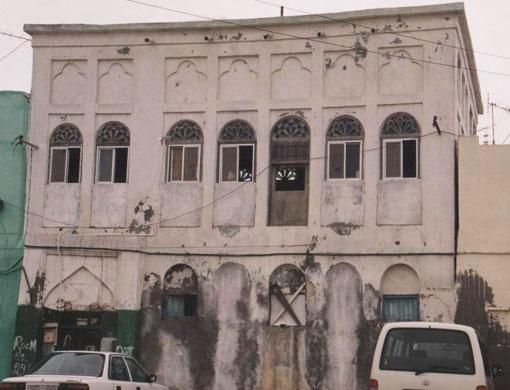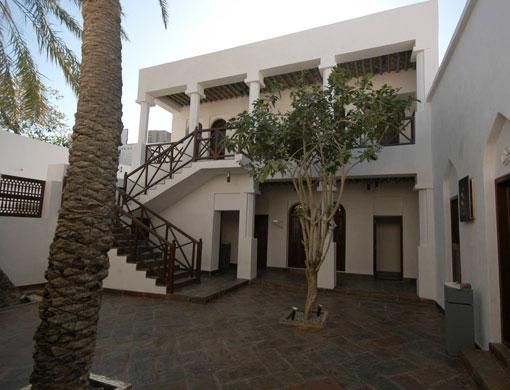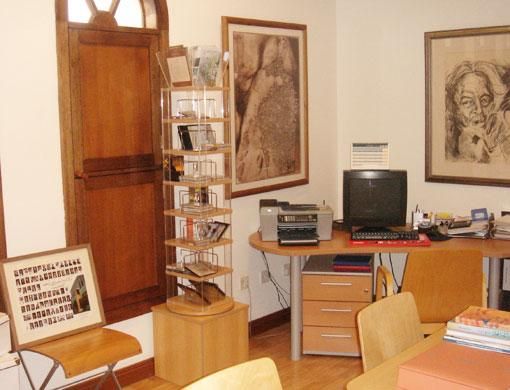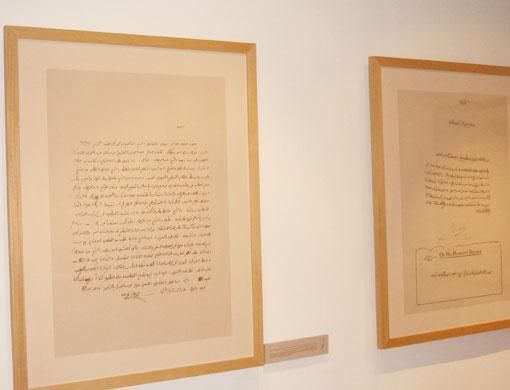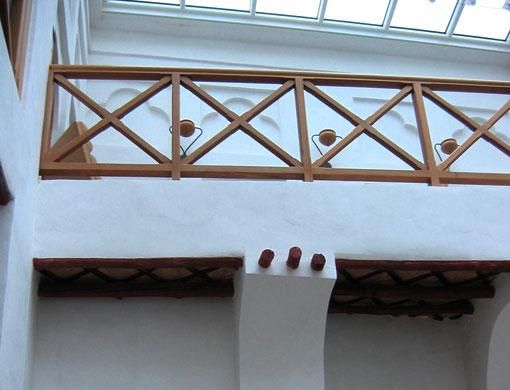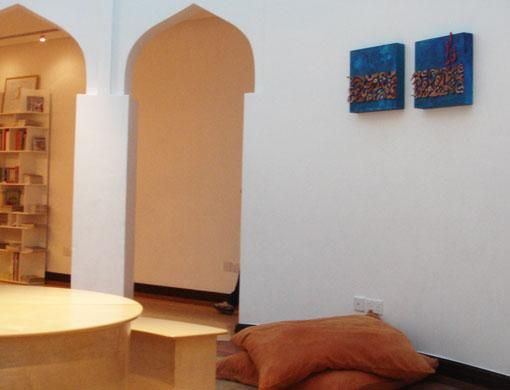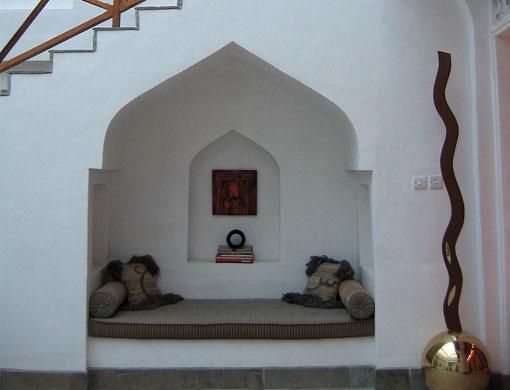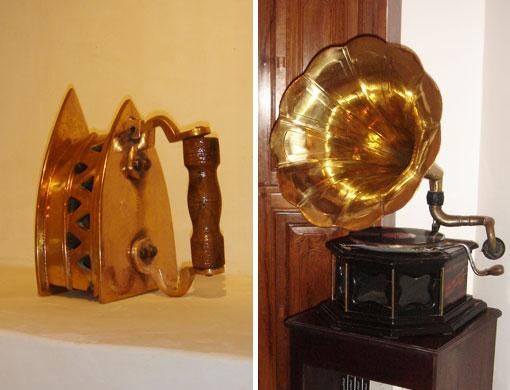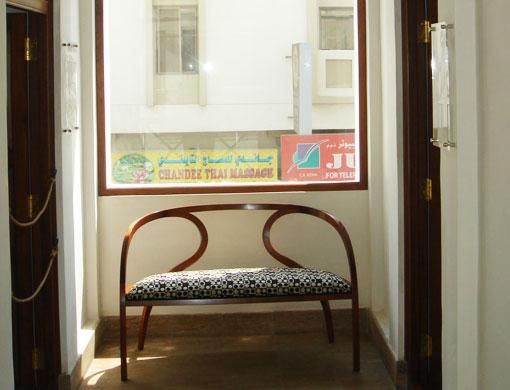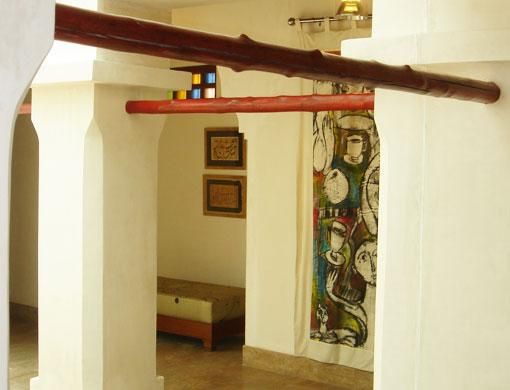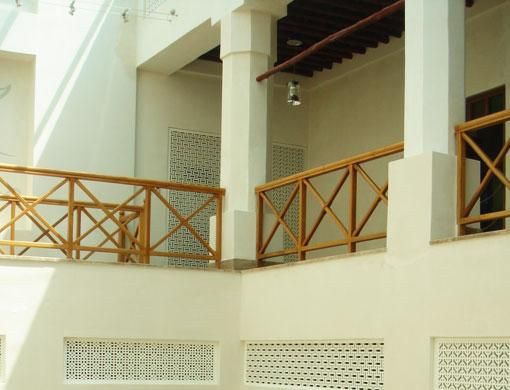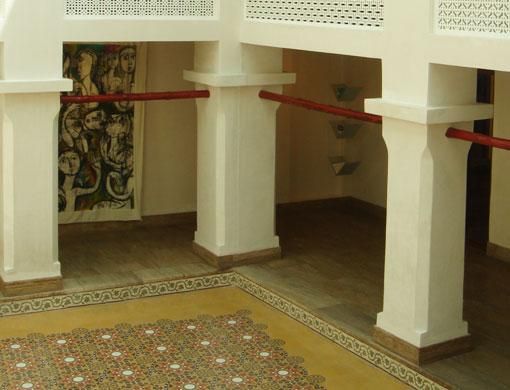In its heyday, the majlis (community salon) of Shaikh Ebrahim Bin Mohammad Al Khalifa in Muharraq, Bahrain's former capital and now its second-largest city, used to be a sought-after forum for discussions and other culture-centric activities. Its renowned library boasted a catalogue of newspapers from all over the world.
The majlis was demolished in the 1970s. However, that bit of Bahrain's cultural and architectural heritage is now back in its rightful place in the form of the Shaikh Ebrahim Bin Mohammad Al Khalifa Centre for Culture and Research.
The centre was the first to come up — in 2002 — in a series of heritage projects undertaken in Bahrain through the past six years.
For Shaikha Mai Bint Mohammad Al Khalifa, who is behind the conception and execution all the projects, the centre is as much about the restoration of Bahrain's heritage as it is a modern recreation of the majlis of her grandfather, after whom the centre is named.
The centre now relives the halcyon days of the majlis, hosting lectures and exhibitions. Its well-stocked library and research and study space attract scholars in droves.
The centre has also published many Arabic and English books pertaining to Bahraini culture and history, including Pearl, Dreams of Shell: Anthology of Bahrain Contemporary Poetry and Vittorio Winspeare Guicciardi: His Role in Affirming Bahrain's Sovereignty and Identity.
“I have always liked to promote Bahrain in the best possible way,'' says Shaikha Mai, who is also an historian and has authored seven books.
With a Masters degree in Political History from the University of Sheffield, United Kingdom, Shaikha Mai's engagement with her country's historical narrative deepened from the time she came across some of her grandfather's historical documents and became aware of the possibilities of a different perspective on Bahraini history.
Her reverence for history and the need to promote awareness and appreciation of the richness of Bahraini history resulted in Shaikha Mai pursuing heritage-oriented activities.
She has been the chairperson of the Board of Trustees for the Shaikh Ebrahim Bin Mohammad Al Khalifa Centre for Culture and Research since January 2002.
When Shaikha Mai embarked on creating the centre, she had to purchase even the land on which her grandfather's majlis had stood.
That first endeavour led her to take on the mission of purchasing and restoring several other old houses in Muharraq: Bait Abdullah Al Zayed (House of Bahrain Press Heritage), Bait Mohammad Bin Faris (House of Music), House of Kurar (House of Embroidery) and Iqra House, housing a children's library (see sidebar).
Each building honoured and promoted specific cultural aspects.
Shaikha Mai then turned to the house of Ebrahim Al Arrayed, one of the foremost poets in Bahrain and a literary luminary of the region.
She converted the house in Guddaibiya, Manama, into Ebrahim Al Arrayed — the House of Poetry.
“I would not be finished with one project before another came up,'' she says, adding that there are five more projects in the offing.
These efforts have helped resuscitate elements of Bahraini heritage. In preventing the houses from being demolished or ruined, Shaikha Mai has succeeded in preserving a slice of the traditional architecture of the region.
The house of Ebrahim Al Arrayed, for example, was about to be demolished and replaced with a four-storey apartment building had Shaikha Mai not intervened and bought it from its owner.
The intention was to restore the house to its traditional appearance by using a combination of traditional and modern building techniques, materials and finishings.
Photographs of the houses taken before and after the restoration attest to the transformation that these buildings have undergone.
The preservation of the houses, which used to be home to Bahraini cultural icons, indicates a recognition of their fields of activity and a determination to continue promoting and facilitating contributions towards them.
Abdullah Al Zayed, for instance, pioneered the development of Bahraini media while Mohammad Bin Faris specialised in a unique form of music known as Sut.
The preservation of these houses is as much a preservation of cultural heritage as architectural. Visitors are able to engage with and get a glimpse of the lives of these icons when they look at their former rooms and habiliments.
“There is identity and memory: identity [in] the special architectural design of a building and memory [in] all past events that took place on this island,'' Shaikha Mai says.
“The wandering spirit of traders, divers, pearl merchants, artisans, writers, poets and ordinary people will tell us about the memories of the places.''
Having previously worked with Bahrain's ministry of information where her responsibilities involved setting up a museum at the site of the Bahrain Fort and being involved with the Bahrain National Museum, Shaikha Mai proceeded to restore the houses in traditional Bahraini architectural style while being sensitive towards adapting them to contemporary use.
“It was equally crucial to identify how best we could restore the houses and make them beneficial for the community,'' Shaikha Mai told Weekend Review.
The well-preserved and maintained houses are, therefore, not just museums showcasing heritage and housing historical objects, they also function as contemporary cultural spaces, making them relevant to the community in more ways than one.
The houses are public spaces open to all without any entrance fee or other charges. Each project, she says, has been sponsored by a different bank.
“I convinced [the private sector] that [the projects were good] and they believed in my mission; furthermore, we deliver quality work in a very short time,'' she says.
For instance, at The House of Kurar (House of Embroidery), every Sunday, Tuesday and Thursday a group of Bahraini female weavers, who originally belonged to the Muharraq area, work on a special kind of gold embroidery for the sleeves of a black outer garment called thob worn by Bahraini women.
The embroidery is a team effort in which the women's collective participation is crucial. “This kind of embroidery is unique to Muharraq,'' Shaikha Mai says.
The non-profit enterprise pays monthly salaries to the women and they sell the products themselves. A fashion show for the women's creations is to be held shortly.
Similarly, every month a local poet recites from his/her works at the House of Poetry, thus encouraging the local literary community.
The activity calendars of all these houses remain jam-packed between October and March and has fewer events only during the summer months.
“This year, however, we are starting our programmes earlier than usual — in September — with two special events.
We will honour the late Palestinian poet Mahmoud Darwish with a programme in which a Palestinian poet will participate.
“We will also celebrate the 100th birthday of Ebrahim Al Arrayed with an exhibition and a Lebanese singer reciting one of his poems,'' Shaikha Mai says.
Apart from the obvious attention paid to restoration of the houses, three of the buildings have been upgraded with innovative features, such as skylights, which insulate open areas in the houses from heat and allow them to be air-conditioned while doing justice to their traditional courtyard layout.
Furthermore, while retaining their original architectural elements, such as a colourful, painted wooden ceiling at the House of Bahrain Press Heritage, the houses are also adorned with examples of modern popular culture: abstract paintings, sculptures, installations and plasma televisions.
“If you stick only to the old, you won't be able to appreciate and live with it,'' Shaikha Mai says.
“While honouring the past, we don't actually live in it. It is therefore necessary to have a juxtaposition of the modern and the old to be able to appreciate both.''
Many of the artists whose work features in these houses are Bahraini, establishing an alternative cultural dialogue.
The past and present coexist in these houses that are filled with historical memorabilia. At the Shaikh Ebrahim Bin Mohammad Al Khalifa Centre, we see blow-ups of letters written to the Shaikh and a gun given to him by an Imam of Muscat.
At the House of Kurar, a vintage Singer sewing machine, colourful skeins of Anchor thread and an old iron are displayed alongside carefully preserved thobs, while at the House of Bahrain Press Heritage, an Imperial typewriter, typed letters and original newspapers greet the visitors. At the House of Music, a phonograph and records are on display.
“It is essential that we display these original historical objects for the viewers and make them relate to the historical atmosphere of the place,'' Shaikha Mai says, adding that people fond of collecting historical objects donated some of them to the houses while other items, such as the gun and the sewing machine, came from her grandfather and parents respectively.
“All these objects tell you what Bahrain was like 100 years ago, what was happening then,'' she says.
As a historian she understands that it is vital to decode and display the “story'' embedded in “history''.
There is also a focus on highlighting Muharraq's rich architectural urban fabric through these projects.
“Muharraq was the capital of Bahrain until 1923. However, with Manama having become the capital and the country's commercial, political and cultural centre, Muharraq fell into decline,'' Shaikha Mai says.
Restoration of the old houses in Muharraq, Shaikha Mai hopes, will provide an impetus to Muharraq and its community.
“We can only change their future by altering their present,'' she says. For example, at the Iqra House, which houses a children's library and computers for the their use, a teacher comes thrice a week to read from Arabic and English books in an attempt to encourage children to read. During the evenings, children troop in and out of the library.
“When I began these projects, I was often asked if people would be willing to travel all the way to Muharraq. My answer now is yes. All important and distinguished visitors have come here,'' Shaikha Mai says.
Referring to a visit by Tadao Ando, she says the famous Japanese architect had lavished praise on the endeavours, saying visitors will take back much with them after trips to these houses and Muharraq.
Shaikha Mai feels it is vital that visitors to Bahrain come to this part of the kingdom, too, during their sojourns. “It is here that one obtains a vivid sense of Bahraini identity and expression,'' she says.
Shaikha Mai is also planning to build a well-equipped research centre adjacent to the Shaikh Ebrahim Bin Mohammad Al Khalifa Centre for Culture and Research.
It will have important links with universities, libraries and archives all over the world, thus encouraging local and international scholars to conduct research into the history of Bahrain.
She is eager that visitors coming to these centres be made aware of Bahrain and the influential historical and political role it played in the early 20th century along with other Arab states.
There are several other projects in the offing: The House of Coffee, for example, will celebrate the significance of coffee in Bahraini culture while another restored Muharraq building, the Matar House, will be a gallery space dedicated to showcasing Bahraini art.
Extensions are also to be made to the music and press heritage houses. Traditional bands will perform at the extension to the House of Music while media-related activities will be organised at the extension to the House of Bahrain Press Heritage.
His Majesty King Hamad Bin Isa Al Khalifa is sponsoring an extension to the Shaikh Ebrahim Bin Mohammad Al Khalifa Centre for Culture and Research — the addition comprising a modern lecture hall with greater capacity, better seating, an updated sound system and visual aids.
Shaikha Mai feels the Bahraini community has embraced these ventures, having become aware and appreciative of their great cultural legacy.
“I also hope that people possessing such old homes, inspired on their own, will think about restoring and maintaining their houses,'' she says. “If these old homes can be so successfully restored, why can't theirs be?''
Testimony to the work Shaikha Mai pursues with single-minded dedication comes from her people, as I learnt while travelling in a taxi and chatting with its articulate driver.
During our conversation, I mentioned the purpose of my trip to Bahrain and referred to the personality I have come to meet. “Oh! Shaikha Mai!'' the driver exclaimed, immediately furnishing me with a brief biography of her, including her recent efforts in Muharraq.
“We in Bahrain need more people like her,'' he says. “She is doing a lot for Bahraini heritage and I hope she continues doing her good work.''
Muharraq
Bahrain's former capital and located on an adjoining island, Muharraq provides a glimpse into an alternative Bahrain with its old, traditional style-houses, bustling bylanes and frenetic activity.
Shaikha Mai Bint Mohammad Al Khalifa hopes that while visiting these houses, visitors take the opportunity of engaging with a different kind of Bahrain showcased in this space.
Guddaibiya, Manama
- Ebrahim Al Arrayed (House of Poetry):
This house, opened in April 2006, is a venue for poetry sessions and commemorates one of Bahrain's foremost poets and literary figures, Ebrahim Al Arrayed.
The multilingual poet lived in the house for more than 30 years. An extension of the building houses a public space for lectures and exhibitions.
Muharraq houses
- Shaikh Ebrahim Bin Mohammad Al Khalifa Centre for Culture and Research:
This building in Muharraq stands where the majlis of Shaikh Ebrahim Bin Mohammad Al Khalifa originally stood before it was demolished in the 1970s.
Opened on January 12, 2002, the centre hosted to more than 1,050 artists, speakers, philosophers, poets and thinkers.
The centre has an exhibition/lecture hall, a library and a research and study space. It will soon have a research centre. - Bait Abdullah Al Zayed (House of Bahrain Press Heritage):
The 120-year-old house of poet, writer and journalist Abdullah Al Zayed, who founded the first Bahraini newspaper, ‘Al Bahrain', in 1934, the House of Bahrain Press Heritage contains the first editions of many local and regional magazines and items that belonged to Al Zayed.
The house features striking traditional elements such as stained glass windows and a beautiful painted wooden ceiling.
Opened in November 2003, it contains a library and media space and functions as a press heritage centre. A further extension is planned for this building. - Bait Mohammad Bin Faris (House of Music):
This house, opened in September 2005, honours the Bahraini musician Mohammad Bin Faris, an exponent of the form of music called “Sut''.
This genre originated in the Arabian Gulf region and was refined by Bin Faris in the last century. The house contains Bin Faris's belongings such as records and musical instruments. There are plans to extend this house. - House of Kurar (House of Embroidery):
Originally an old, crumbling house located in the Muharraq area, the building was restored and converted to revive a kind of gold embroidery unique to Muharraq.
Women practitioners of this embroidery gather at the house thrice a week, work on the pieces and sell them. A fashion show will shortly be held there, showcasing the women's work. - Iqra House:
The home of a children's library, it is frequented by the young of Muharraq; a teacher visits the house every Sunday, Tuesday and Wednesday, reading in Arabic and English and conducting library-related activities with the children.
Priyanka Sacheti is an independent writer based in Muscat, Oman.



